Leo wrote:
Later type KH500 inners offer more rebound damping
which is a plus.
You can further improve fork action by reducing
diameter of small bore to 1.8 mm and thus increase rebound damping. On top of
that, you can reduce compression damping by drilling trough aluminum top of
inner rod with 8 mm drill bit. One should close two of the four holes on
the lowest part of the inners.
H-forks have stock springs that are close to OK. Just increase oil level to keep
it from bottoming out under severe braking. btw, severe braking is not possible
with stock brakes.
Only if you are way over 130 lbs you will need to change to a stiffer spring.
I have found the 18 inch front wheel to work well up to speed of 100 mph. Past
that it becomes unstable. Reduction of triple clamp off-set by 5 mm helps some.
Best thing to do would be to drop an engine into an S-frame. Your worries are
over right away.
Per John Aylor:
Here are side by side pics of the
aluminum vs steel H2 damper rods.
The recommended modification for the bottom of the steel rod
is to weld up two of the four holes and drill the other two out to 1/4".
The damping hole in the side of the rod about 2" down from the top. It is
about 5/64" diameter (2mm) and is in the same place on both style rods.
It should be 1.8mm, might be a small hole
but the size % difference is pretty big. Almost 20%.
Polish and check after
welding to make sure the fork slides smoothly on the damper, as well as the
damping parts on the rod after filling the small damping hole.
Pic 1: Steel late model on top with bottom being early aluminum
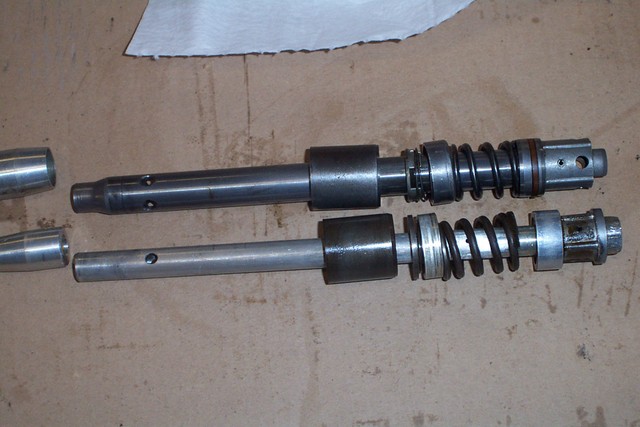
Pic 2: Same as pic 1 except the items are dissasembled.
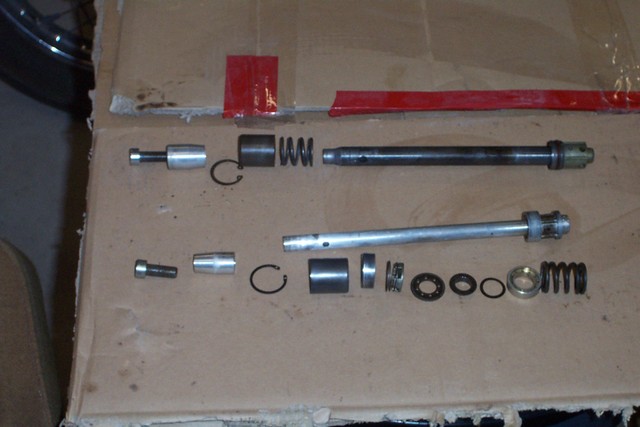
Pic 3: Early model aluminum bottom hole close up
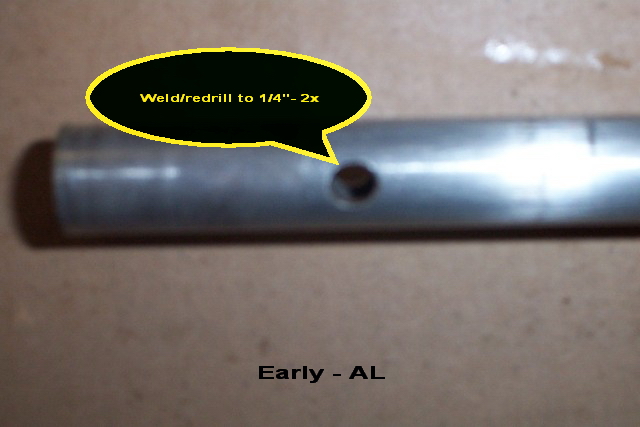
Pic 4: Early model aluminum top portion of rod close up.
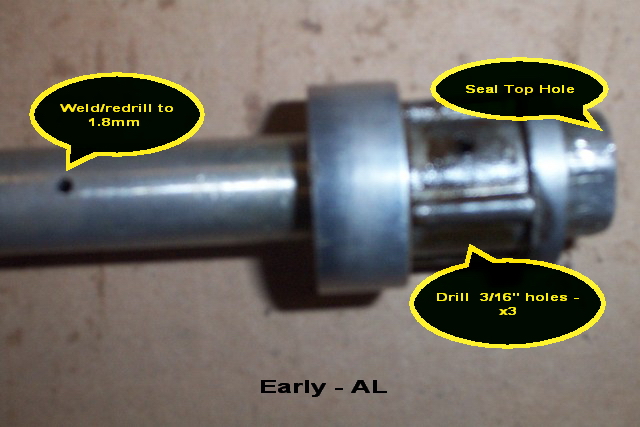
Pic 5: Late Model steel bottom portion of rod close up.
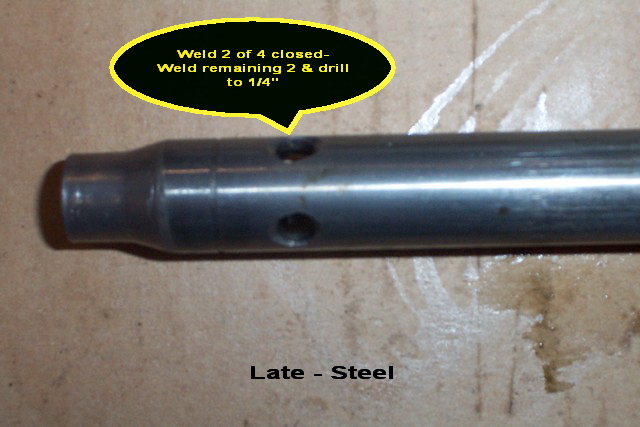
Pic 6: Late Model steel top portion of rod close up.
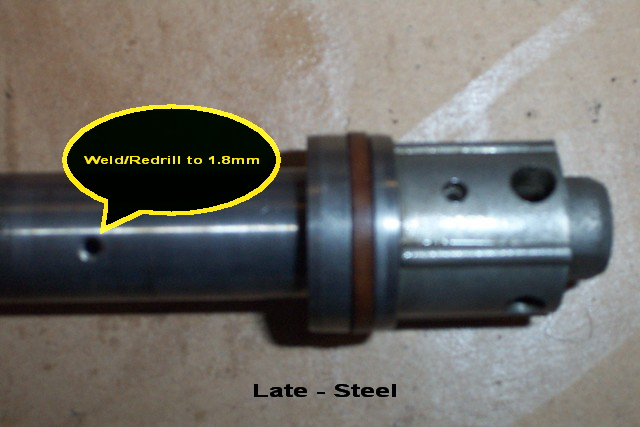
Emulators
Oxford's emulator fitting mod:
I made up some adapters to run racetech emulator clones available through
MikesXs on my bike. I ran a few extra sets off and I am offering the adapters
and the mods to your fork rods as a package. Here is a link to the emulators https://www.mikesxs.net/product/27-1086.html
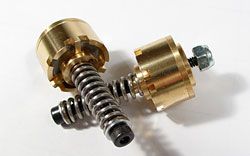
Mike's emulator installation
manual
Mike's emulator drawing
And here is what you will get from me:
Stock fork rod ref:
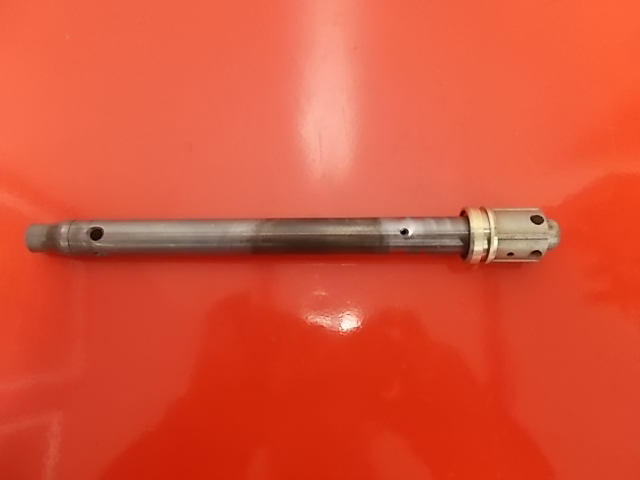
I then drill additional compression holes in the bottom of the rods.
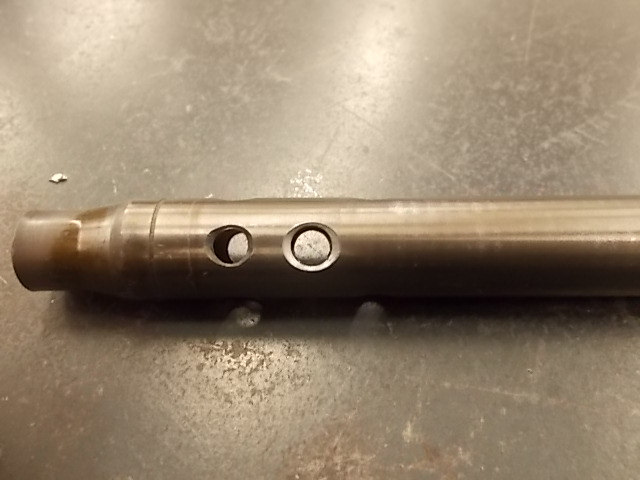
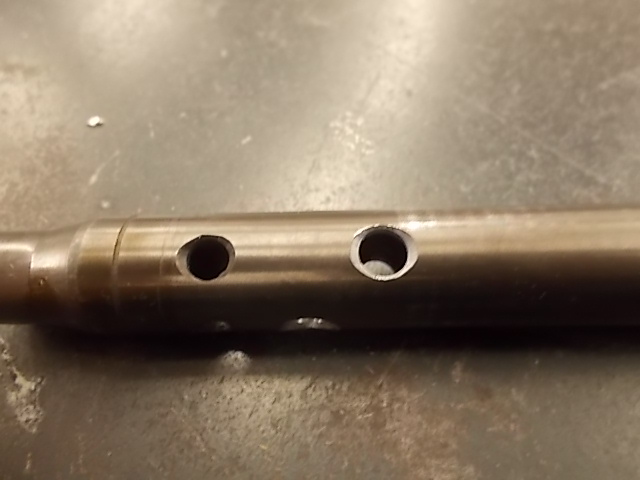
I then weld the stock rebound hole shut and re-drill it to 1.57mm. I can also
drill the hole to your spec or leave it stock if you like.
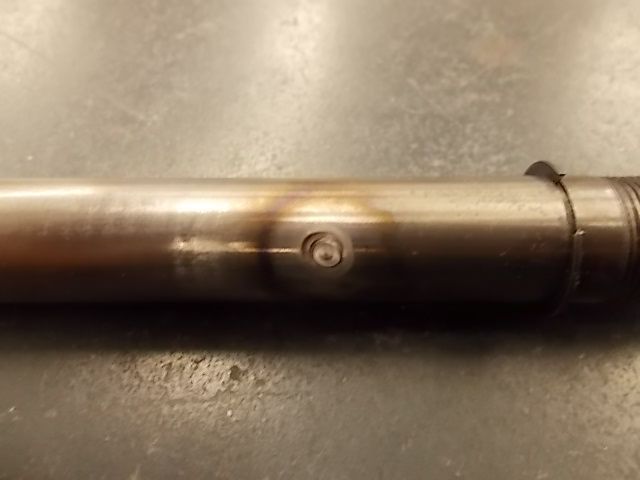

Here are the adapters, they replace the stock rod top and are secured with dog
point set screws instead of the roll pin. This is for better flow to the
emulator.
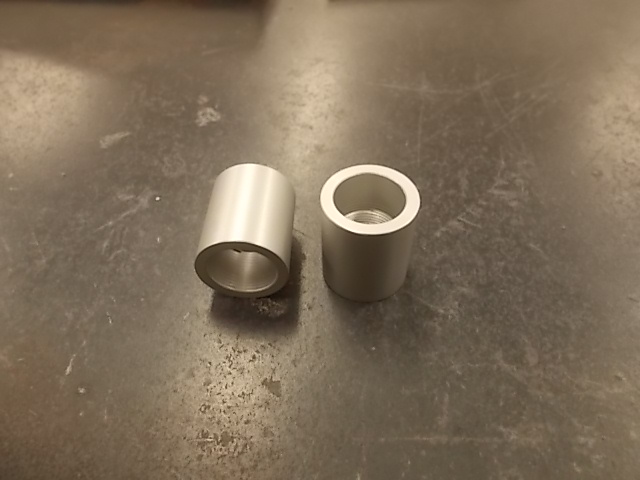
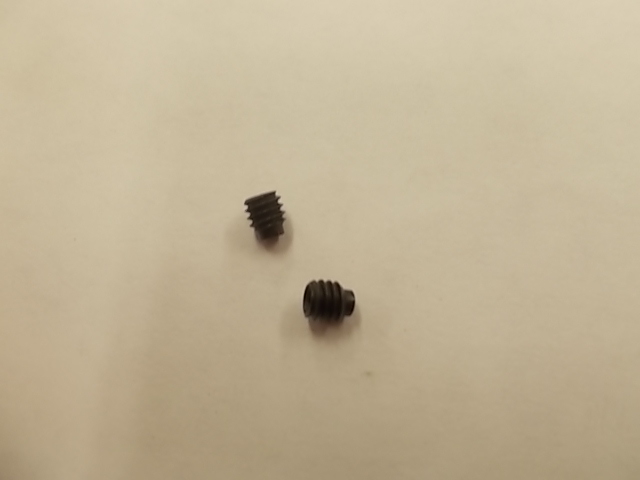
Here are the finished rods and also shown with the emulators sitting on top.
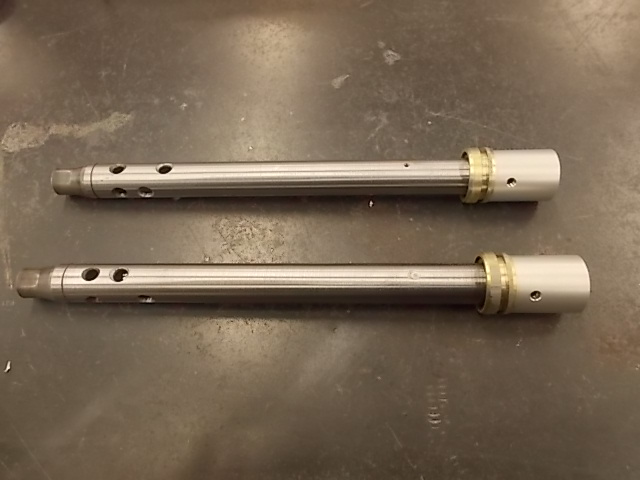
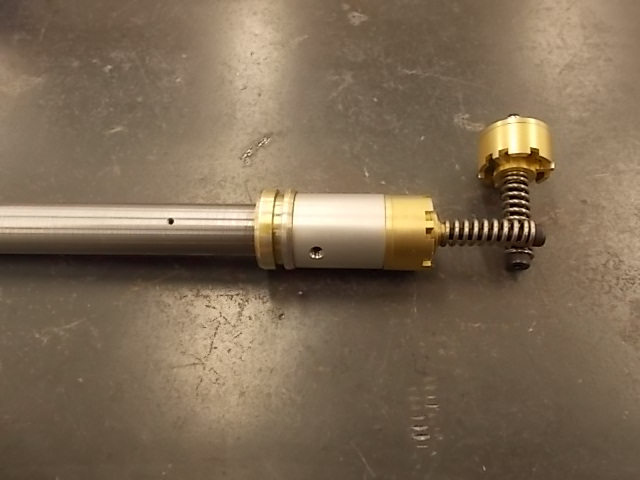
The cost for this is $80 for both rods plus return shipping. I will need your
rods sent to me stripped down like in the first picture and cleaned/degreased as
best as possible. There is also a seal for the piston( piece under the stock
rod top) that needs to be removed. It is already removed in the first picture.
They will be returned to you ready to go looking like the 2nd to last picture.
Paypal is ok but you need to add 3% if not sent as a gift. You can also add in
the same shipping amount that it took to send the rods to me for the return
shipping. Cash sent in the box with the rods is also ok.
Here is a little bit of info on emulator installation in general. First off,
the installation procedure and picture on the resource site is not correct
whether you are using the racetech brand or the clones. The top of the rod
needs to be opened up so oil can flow through it and through the emulator. They
do not work if oil is not flowing though it. You can machine the top of the
stock rod top off and use an adapter like race tech does or replace it entirely
with a new top like I did. If you are planning on running emulators you will
need some machine work done or some very careful sanding/filing.
You also do not need to weld or close holes shut on the bottom compression
holes. The holes on the bottom of the rod serve no purpose with the emulators
other than a port to let the oil through and up to the emulator. This is why
additional holes are drilled, to give more surface area for the oil to flow
freely.
jeffabbyisaac@yahoo.com
Jim C.'s emulator fitting mod:
Please note that the info presented below
may out of date or incorrect as noted by Oxford. FEGV 3004 is now listed for
late H1/H2. Check with Racetech before ordering or modifying fork rods.
Oxford wrote:
I just wanted to let you know that the info
on the resource page about the racetech emulator install info is wrong. The top
of the factory rod top needs to be machined off so the rod is opened up and oil
can flow to the emulator. When using the stock rod top that is pictured on the
resource page, there is no oil going to the emulator. It is still working like
the stock compression does.
You also do not need to weld or close up holes like the description on the
resource page says. You only need enough surface area with holes so the oil can
flow freely up to the emulator. This means adding some, but you of do not need
to weld any shut on the compression side of things. If changing the rebound
hole, welding the hole shut may be required.
Emulator Installation Instruction Sheets
2
Jim C. wrote:
John's mod to the alum rods is really good when you are
not using
the Race Tec cartridge emulators. He is not removing nearly as much material as
Race Tech. I have sets of both alum. and steel and felt that the R.T. mod for
aluminum was a potential structural issue.
Here's the article I wrote for the UK Club
Magazine awhile back:
Fork Improvements for the H Series Triple
by Jim Crenca
First off, this mod is the greatest thing since sliced bread; my H2 now has real
hydraulic damping with great dynamics over rough streets, speed bumps, hard
front brake use, etc.
Second, special thanks to Dr. James for explaining that cartridge emulators are
not designed for a specific bike but rather a fork tube I.D.
I had called Race Tech a few years ago and asked if they had or would make an
emulator for my H2; they did not have one and would not make.
While searching their site, they do offer a set for a late model H1 and the
directions are very good.
http://racetech.com/

1. You MUST have a late model H series bike with steel front fork damper tubes.
The aluminum tubes are too small in diameter IMO after you drill 6ea 5/16"
holes. Race Tech doesn't say this but I can't believe that there is not enough
structural integrity with the small diameter soft aluminum tubes.
2. Order 1ea. FEGV S3001 pair of emulators ($169.99) as well as 2ea. FPEV AD3003
adapters ($9.98 for the pair)
The HMWC copper washers for the bottom bolt seal are the wrong size and I didn't
opt for their fork oil at $30 per quart
3. Order 1 quart of Torco RFF Synthetic blend 15wt. fork oil; this stuff does
not feel like regular fork oil and I believe it to have much less stiction;
about $10 per quart.
4. 2' of schedule 40, 3/4" PVC plumbing pipe to replace the original metal
spacer for pre-load (or cut up the original; I wanted the ability to adjust
pre-load after more testing)
5. The fork dampers have 2 sets of clear holes over top of each other. Drill the
bottom set out to 5/16". The set that are directly above need to be sealed; I
threaded this hole and installed Allen set screws, mig welded and ground flush;
then decided this might not be strong enough and brazed around the perimeter.
Not the prettiest work by my hands and would have tig welded the holes closed in
hindsight.
Now drill a 5/16" through hole 10mm (centerline to centerline) above your lower
holes and at 90 degrees. Then drill another set 10 mm CL to CL and again at 90
degrees. You should have 3 clear holes or 6ea holes and might look something
like this:
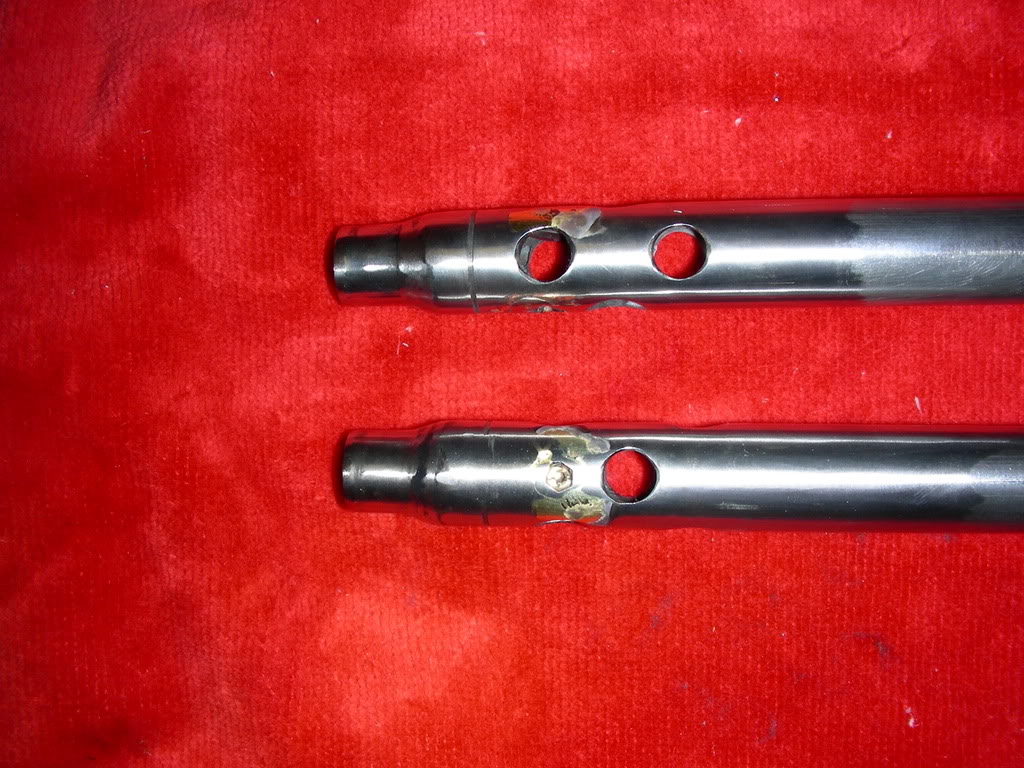
6. You will not use the original damping disc assembly and the new damper sits
on top of the adapter which sits on top of the rod.
7. Here's a close up of the emulator; not terribly complex but not worth trying
to copy (steal) for a lousy $170. Hey, if it's so simple, how comes you didn't
think of it? (John Jacob quote)
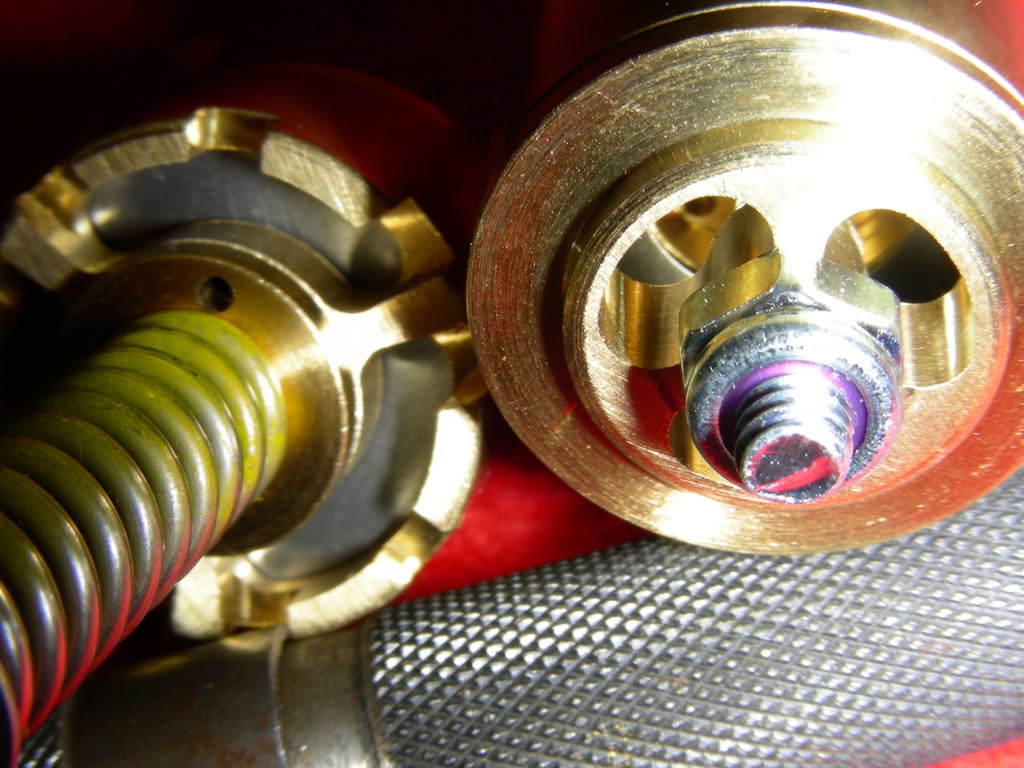
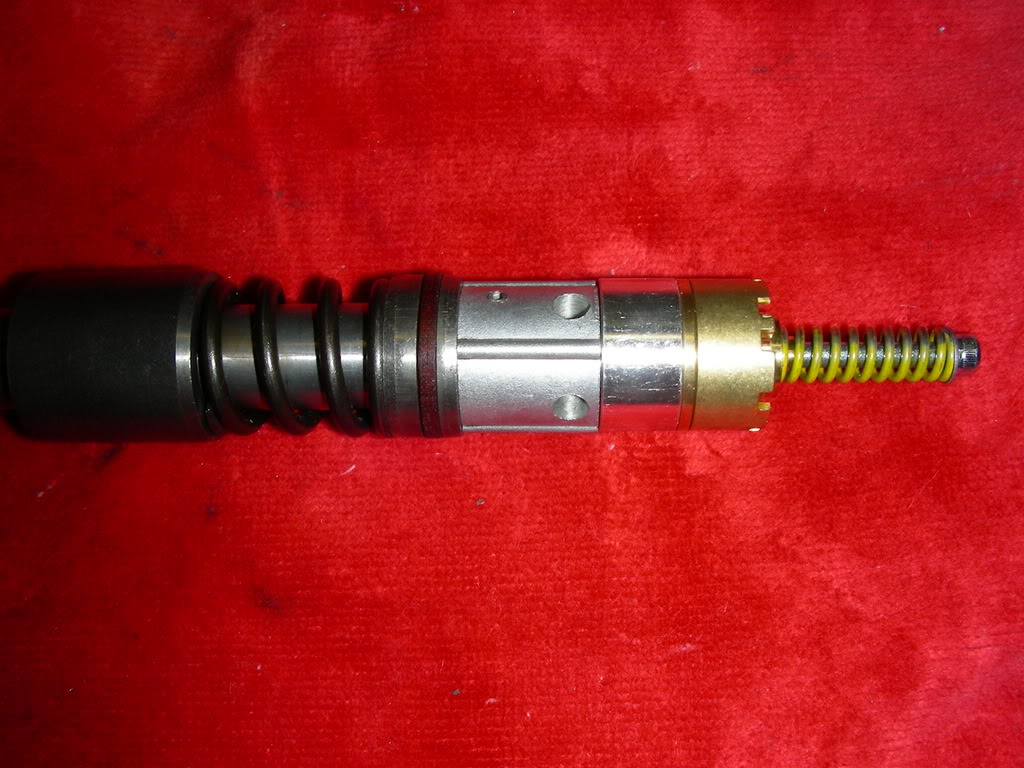
8. I weigh 175 lbs and my bike weighs 430 lbs with fluids. I tried a number of
different weights and race vs. street applications with their "digital valving
search" and always come up with 140 mm of 15 wt oil and 20 mm of preload. They
measure preload as the distance from the top of the top tube to the top sealing
surface of the fork cap. In my case I ended up with something like 88.8 mm
spacers. I'm using the stock springs but Race Tech and Sudco offer progressive
wound springs; not so sure if this mod will add that much but would be
interested to hear from anyone who can A/B the two different springs although
new spacers would probably need to be made.
9. During assembly the adapters are dropped onto the modified rods from the top
and then emulators drop on top of this. I used a high powered LED flashlight and
a magnetic parts pickup tool to get these parts lined up. Once in place the PVC
spacers and fork caps will hold it in place.
10. Take the bike for a ride and please post your results. As of this writing
Iíve put down approx 250 miles with this mod and there may be more improvements
with some experimentation. BTW, I'm using Redwing Hammerhead shocks and the
overall handling improvement was nothing short of great. The stock shocks may
not allow you to get the full benefit as I've never believed these shocks to
work that well.
Best handling improvement for the buck and is added to my personal list of "must
do" mods along with chambers, pods, and Sytec release.
(Still need to rubber mount the H2 after doing this mod to the H1)!
Edit Note: Racetech now lists FEGV 3004 emulator
w/adapter for both H2 & Late H1.
When I bought mine a few years ago they only listed the H1
and couldn't offer any fitment advice to similar bikes other than they are
adjustable. Would be interested to hear what they say about these new part
numbers vs. what they suggested I use.
While these units will not transform the bike into anything close to modern,
they do help damping performance. I've only used them with the oil suggested in
the article.
- Jim Crenca
Emulator Installation Instruction Sheets
Fork
Emulator Mod Diagram by Altered Image



















